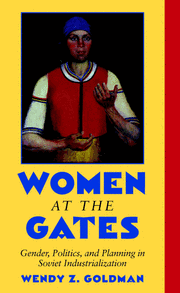Book contents
- Frontmatter
- Contents
- Acknowledgments
- List of Illustrations
- List of Tables
- Acronyms and Abbreviations
- Women at the Gates
- Introduction
- 1 Guarding the Gates to the Working Class: Women in Industry, 1917–1929
- 2 The Struggle over Working-Class Feminism
- 3 The Gates Come Tumbling Down
- 4 From Exclusion to Recruitment
- 5 “The Five-Year Plan for Women”: Planning Above, Counterplanning Below
- 6 Planning and Chaos: The Struggle for Control
- 7 Gender Relations in Industry: Voices from the Point of Production
- 8 Rebuilding the Gates to the Working Class
- Conclusion
- Index
- Plate Section
2 - The Struggle over Working-Class Feminism
Published online by Cambridge University Press: 30 July 2009
- Frontmatter
- Contents
- Acknowledgments
- List of Illustrations
- List of Tables
- Acronyms and Abbreviations
- Women at the Gates
- Introduction
- 1 Guarding the Gates to the Working Class: Women in Industry, 1917–1929
- 2 The Struggle over Working-Class Feminism
- 3 The Gates Come Tumbling Down
- 4 From Exclusion to Recruitment
- 5 “The Five-Year Plan for Women”: Planning Above, Counterplanning Below
- 6 Planning and Chaos: The Struggle for Control
- 7 Gender Relations in Industry: Voices from the Point of Production
- 8 Rebuilding the Gates to the Working Class
- Conclusion
- Index
- Plate Section
Summary
The Zhenotdel has already ceased to be a progressive force and has become a hindrance.
L. M. Kaganovich, Politburo member, 1930Throughout the 1920s, the Party's exclusionary labor policy was strongly contested by women. Many of their objections and complaints were articulated by the Zhenotdel (women's department), an organization created in 1919 by the Central Committee in response to strong pressure coming from both inside and outside the Party. The Zhenotdel struggled to broaden the definition of the working class by highlighting the problems faced by women, including unemployment, prostitution, low-waged work, and lack of skills. Although the Central Committee backed the Zhenotdel, the department's activists still came into sharp conflict with uneducated male rank-and-file Party members whose attitudes toward women did not differ substantially from those of their peasant fathers and grandfathers. From its very inception, the Zhenotdel was at loggerheads with the unions over how to organize women. Despite its difficulties, however, it represented a genuine “proletarian women's movement.”
In the period before World War I, Europe's social democratic parties, including the Bolsheviks, embraced the notions of women's equality and emancipation more wholeheartedly than any other political parties. When the Bolsheviks came to power, they immediately passed progressive legislation concerning marriage, divorce, abortion, property, illegitimacy, and equality – legislative programs that many capitalist countries have yet to adopt.
- Type
- Chapter
- Information
- Women at the GatesGender and Industry in Stalin's Russia, pp. 33 - 69Publisher: Cambridge University PressPrint publication year: 2002



